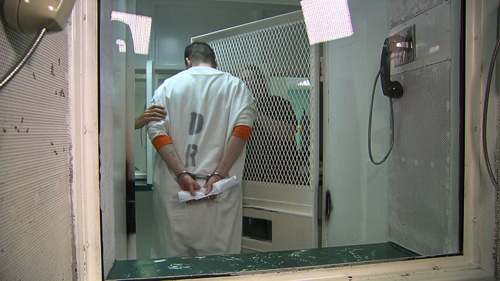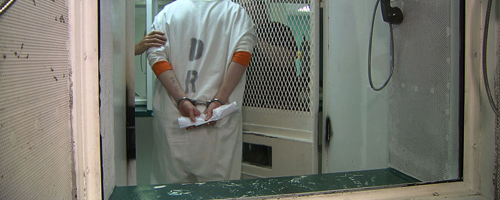It’s very rare, and quite difficult, for documentarians to make an objective movie about a controversial issue: Even if they start with objective intentions, their stance and opinion often have an unmistakable influence on the content of the film.
A tale of death, a tale of life

It’s very rare, and quite difficult, for documentarians to make an objective movie about a controversial issue: Even if they start with objective intentions, their stance and opinion often have an unmistakable influence on the content of the film.
And if the filmmaker is capable of achieving the impossible—of creating a truly objective documentary—viewers infer and generate opinions, as they tend to do, and claim the director shares their point of view.
Werner Herzog has been accused time and again that his documentary Into the Abyss, playing this weekend at Portland State’s 5th Avenue Cinema, is a biased movie about the death penalty.
While the film’s content might be controversial and Herzog explicitly states that he does not believe people should be executed, he has also specified that making a biased statement about the death penalty one way or the other was not his ultimate goal.
Into the Abyss, which is subtitled A Tale of Death, a Tale of Life, was filmed in 2010 and released in 2011. Revolving around a triple homicide case in Conroe, Texas, in October 2001, the film deals with murder, both by the people and the state.
The film’s backstory involves Michael Perry and Jason Burkett, who entered a gated community uninvited, broke into 50-year-old nurse Sandra Stotler’s house (her son, Adam, was their friend), murdered her and stole her Camaro.
Following this ordeal, they called on Adam Stotler and another friend, Jeremy Richardson, to provide the code needed to exit the community. Adam and Jeremy met the same tragic fate as Sandra Stotler once they were no longer needed. A week after these events transpired, Perry and Burkett were involved in a shootout, arrested and convicted.
Unlike in the rest of his movies, Herzog does not show his face on camera, but rather uses his trademark soothing, Bavarian-accented voice to interview the two young men who were convicted of the homicides, the victims’ families and Texas law enforcement.
Herzog remains polite and courteous in the midst of discomfort and, despite the seriousness of the subject, humor somehow manages to shine through.
Perry was convicted of murdering Sandra Stotler, and was sentenced to death row.
Burkett was convicted of murdering Adam Stotler and Richardson, but received a life sentence because of his jailbird father’s touching testimony to the jury.
Perry is eight days from his execution when the movie begins; as the film opens, we are introduced to him. He appears to be upbeat and positive but ultimately broken.
It’s a recurring theme throughout the movie: Through the stories and interviews, Herzog somehow manages to generate both sympathy and disgust for the two young prisoners.
Two of the victims’ family members are interviewed, Jeremy’s older brother and Adam’s sister, who is also Sandra’s daughter. Both people describe their deceased sibling as their best friend.
While Jeremy’s brother seems to be more focused on the grief he still feels over having lost his brother, Adam’s sister is bitter at the universe and Perry for taking the last of her family from her. It’s ironic that her bitterness is centered on Perry, as Burkett was found guilty of the same.
Into the Abyss
Friday, March 1, and Saturday, March 2, at 7 and 9:30 p.m.
Sunday, March 3, at 3 p.m.
$3 general admission, free for PSU students with ID
I shivered with chills and goosebumps despite my desensitization to the subject matter (thanks to countless television shows and movies revolving around murder, murderers and penitentiaries). The film uses police footage from that gruesome night in 2001, including footage of evidence, bullet casings on the ground, bullet holes in walls and cars, blood and corpses.
The footage is far from the only disturbing aspect of this film. The soundtrack provides an ominous and depressing overtone. There is rarely any music during the interviews themselves, but the music is played during police footage, transitions and dramatic, emotional moments, and it only heightens the tension.
Herzog, who wrote, directed, and narrated Into the Abyss, is from Germany. He made his directorial feature film debut in 1968, at the age of 26. Since then, he’s added 59 other works to his filmography.
The majority of his oeuvre features heroes with impossible dreams (The White Diamond), the beauty of nature (Encounters at the End of the World) and people who attempt to change nature but are ultimately overwhelmed by it (Grizzly Man).
There’s no doubt he’s well-versed in the art of culture and people. In one way or another, he’s traveled across the globe—to South America, Antarctica, Siberia, France, the U.S. and myriad places in between—to tell his stories. In fact, Herzog’s the only director with the honor of having made a feature film on every continent.
Into the Abyss was not made to sway people this way or that in terms of the death penalty. It was made to demonstrate humanity and what happens when it’s no longer present, be it in a house or in a cell.
Abyss is at times disturbing, and whether the ending is happy depends upon the viewer’s opinion of the death penalty itself. Either way, Into the Abyss provides excellent insight into the world of murder and murderers.







